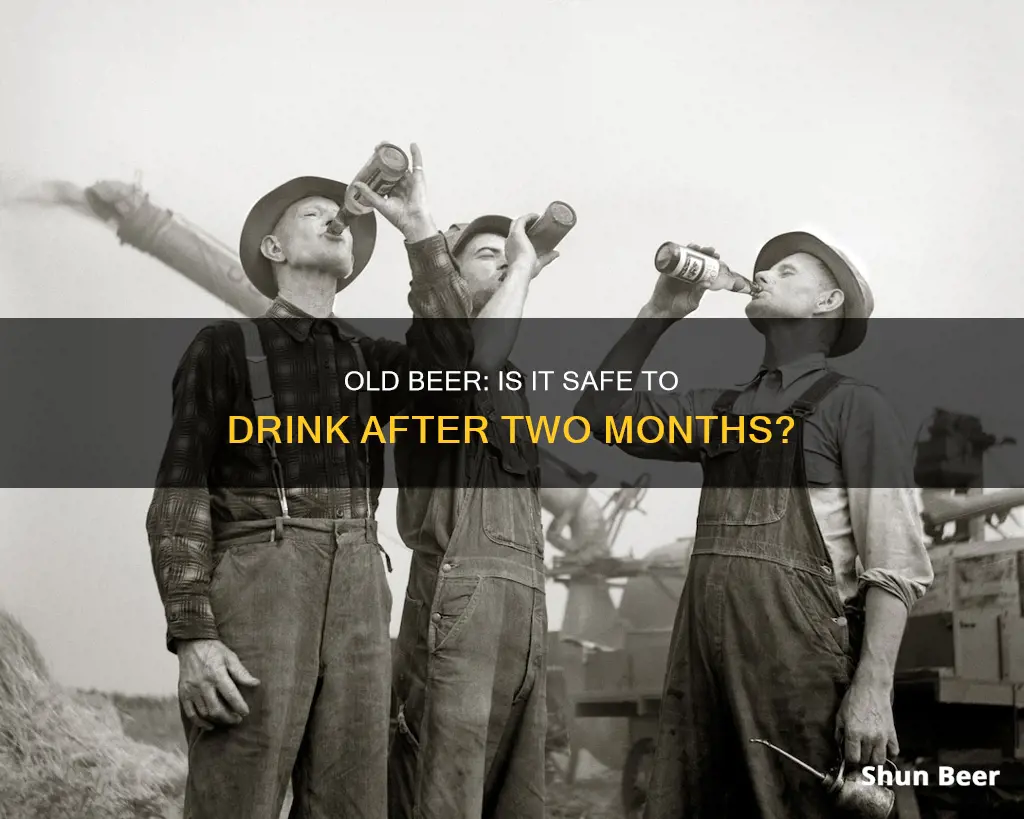
Beer is a beloved beverage for many, but what happens when it's left sitting for a few months? Can you drink 2-month-old beer? The short answer is yes, you probably can. Beer doesn't typically expire in a way that will make you sick. In fact, people have been known to drink beer that is decades old without severe issues. However, this doesn't mean it will taste good. The flavour of beer changes over time, and while some beers age well, others do not.
| Characteristics | Values |
|---|---|
| Is it safe to drink? | Yes, it is safe to drink beer that is 2 months old. There are no pathogens that can survive in beer. |
| Will it taste good? | Probably not. The taste of beer changes over time, and it is likely that the beer will have a vinegary or "wet cardboard" taste. |
| How to store beer | Beer should be stored in a cool, dark and consistent environment, preferably a refrigerator. |
What You'll Learn
- Beer doesn't expire, but the flavour will change over time
- The style of beer will impact how the flavour changes over time
- How a beer is packaged will impact how the flavour changes over time?
- Temperature impacts how a beer's flavour changes over time
- Beer is best stored in a cool, dark, consistent area

Beer doesn't expire, but the flavour will change over time
Beer is a curious beverage. It doesn't expire, but its flavour profile will change over time. This is due to the oxidation of the beverage, which occurs when oxygen interacts with the compounds from malt, yeast, and hops—the building blocks of what makes beer so delicious. This process gives the beer a disappointing papery or cardboard-like taste.
The good news is that even if your beer is two months past its expiration date, it's still unlikely to make you sick. The fermentation process used in brewing, as well as its low pH level and alcohol content, make beer an unfriendly environment for microorganisms. So, unless the seal has been broken and bacteria have gotten in, you should be able to drink it without any health risks.
However, the taste of the beer will have changed. Hop aromas, in particular, are time-sensitive. Those citrusy, floral, and tropical notes that you love will be the first to go. The sweet, grainy, caramel notes of a malty beer, on the other hand, increase as the beer ages. That's why heavier beers with higher ABV tend to have greater longevity.
So, if you're wondering whether to drink that two-month-old beer, the answer is: it's probably safe, but it might not taste as good as you remember.
Kratom and Beer: Safe Mix or Risky Cocktail?
You may want to see also

The style of beer will impact how the flavour changes over time
The style of beer will impact how its flavour changes over time.
Light body, low ABV beers tend to have their flavour deteriorate faster than darker, high ABV beers. For example, a 10% ABV Imperial Stout can handle years of ageing, while a 4% American Lager will see flavour changes in the first year.
The ageing process is characterised by a decrease in bitter taste and an increase in sweet and caramel flavours. Beers with a lighter body will experience these changes faster.
The ingredients used in the brewing process will also influence how the flavour of a beer changes over time. Beers brewed with barley will have a cleaner, sweeter, and milder malt flavour than beers brewed with wheat, rye, or oats, which can add a crisp, spicy, or dry flavour.
The roasting technique used on the grains will also impact the flavour changes that occur during ageing. The longer the grains are roasted, the more burnt and bitter the beer will taste. Beers brewed with chocolate malt, for example, will have a stronger roasted flavour and be better suited for ageing than beers brewed with pale malt.
Additionally, the packaging of the beer will impact flavour changes over time. Canned beer will maintain its flavour better than bottled beer because cans prevent light from entering and maintain an airtight seal.
Shanghai's Public Drinking Laws: Beer Allowed?
You may want to see also

How a beer is packaged will impact how the flavour changes over time
The packaging of beer has a significant impact on its flavour and freshness over time. Brewers typically use either aluminium cans or glass bottles to package beer. In recent years, there has been a shift from bottles to cans, which has been attributed to small canning lines becoming more accessible for craft brewers, changes in consumer activity, and supply chain challenges during the COVID-19 pandemic.
Aluminium Cans
Cans do a much better job of preserving the flavour of beer over extended periods than bottles. This is because they prevent light from entering the beer and maintain an airtight seal. However, the migration of hop volatiles into the can coatings has been observed, which can result in "flavour scalping" of certain hop terpenes, causing them to be left behind in the packaging instead of making their way into the beer.
Glass Bottles
Glass bottles can be dark brown, green, or clear. The darker the colour, the better the bottle is at preventing UV light from reaching the beer and causing it to "skunk". Even dark bottles still let some UV light through, and the seals on the bottle caps can break down over time, allowing air into the bottle.
Other Factors
The freshness of beer at the time of purchase is also important, as is the consistency of the temperature at which it is stored. Fluctuations in temperature can negatively impact the flavour of beer, and it is best kept under 50 degrees where possible.
Beer and Zarelto: Safe or Not?
You may want to see also

Temperature impacts how a beer's flavour changes over time
The flavour of beer is affected by temperature because different flavours are released at different temperatures. When beer is too cold, it can lose its flavour, and when it is too warm, it can taste overly sweet or bitter. Temperature also affects the carbonation of beer. When served too cold, carbonation can be suppressed, resulting in a flat or lifeless taste. When served too warm, carbonation can be overemphasised, leading to a fizzy and unpleasant experience.
Additionally, temperature affects the aroma of beer. When beer is too cold, it can lose its aroma, making it difficult to detect its full range of flavours. When it is too warm, it can develop an unpleasant smell, further affecting its taste.
It is important to note that the larger the sample of beer, the slower it will warm. Therefore, the serving temperature should be adjusted accordingly. For instance, a full pint will warm slower than a 3oz sample.
Mixing Mucinex and Beer: Is It Safe?
You may want to see also

Beer is best stored in a cool, dark, consistent area
When it comes to storing beer, temperature is key. Beer stored in warmer conditions will age faster. The ideal temperature range for storing beer is between 50 and 55 degrees Fahrenheit, also known as "cellar temperature". This range is much cooler than modern room temperature, which is typically around 72 degrees Fahrenheit.
Storing beer in a refrigerator is ideal, as it maintains a cool and consistent temperature. If you don't have access to a refrigerator, a basement, closet, or under-bed storage are good alternatives. These areas are relatively cool and protected from sunlight and fluorescent light, which can cause "skunking".
In addition to temperature control, it is important to shield beer from light exposure. Beer stored in clear glass bottles can become "light-struck" or "skunked" in under one minute in bright sunlight, a few hours in diffuse daylight, and a few days under fluorescent lighting. Brown glass bottles are best for blocking out light, followed by green glass bottles, which still allow some light under 400 nanometers to pass through.
Consistency in temperature is also crucial for preserving beer. Allowing beer to warm up and cool down repeatedly can negatively impact its flavour. Therefore, it is best to store beer in a place with a steady temperature, avoiding areas that are too hot or too cold.
By storing beer in a cool, dark, and consistent area, you can help maintain its freshness and prevent flavour loss.
Beer and Sickness: What You Need to Know
You may want to see also
Frequently asked questions
Yes, it is safe to drink 2-month-old beer. Beer doesn't expire and there are no known pathogens that can survive in beer.
It depends on the type of beer and how it was stored. Light body, low ABV beers tend to have their flavour deteriorate faster than darker, high ABV beers. Beer stored in a cool, dark and consistent environment will taste better than beer that has been exposed to heat, light and temperature fluctuations.
If your beer has lost its fizz, it's likely that the seal has been broken and the beer has been exposed to oxygen. If your beer has a vinegary taste, this is a sign that bacteria has gotten in.
Keep your beer in a cool, dark and consistent environment, preferably a refrigerator. Store your beer upright to minimise its exposure to oxygen and drink it as close to its "born on" date as possible.







